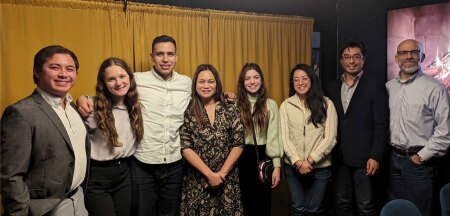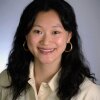
Cohort 5 health mentees and mentors gather for dinner and program reflection in Dallas as part of the 2022 ULI Fall Meeting. From left to right: Bryan Luu, Liz Rose, Jude Hernandez, Malee Tobias, Lyna, Denise Truong, Riki Nishimura, Michael Bloom. (Cohort 5 participants not pictured: Rives Taylor and Leroy Moore.)
Each year, the ULI/Randall Lewis Health Mentorship Program pairs five exceptional graduate students with Institute members to learn about the organization, develop relationships with members, and deepen their understanding of opportunities to advance health through careers in land use and real estate. In October, Cohort 5 was brought together by ULI Building Healthy Places (BHP) at the 2022 ULI Fall Meeting in Dallas. Alongside their mentors, mentees attended product council meetings, participated in health- and sustainability-related forums and tours, including ULI’s Building Healthy Places Forum, as well as micro-learning and concurrent sessions.
ULI’s annual spring and fall meetings provide unique opportunities to connect a wide array of real estate and land use professionals at all stages of their careers. Engaging with and learning from one another, attendees of these meetings are inspired to confront and share ideas on how our field can advance healthier, more resilient, and sustainable communities. Here, health mentees share their reflections and observations on the interconnectedness of health, equity, and the built environment based on their meeting experiences.
Are you a graduate student interested in connecting with ULI and its members on advancing health through the built environment? Are you a full member on a product council who would like to serve as a mentor? Applications for Cohort 6 mentees and mentors are now open through January 19, 2023. Learn more and access the applications here.
How did the 2022 Fall Meeting make you think differently about health and equity in real estate?
Bryan Luu: Through the different discussions and panels, I understood the urgency for change in the health and equity of spaces. People talked about their efforts to mitigate natural disasters, and others showcased their involvement with the community to ensure they are building a brighter future. I asked myself throughout the week what real “sustainability” looks like and how the difference in a person’s definition can impact the final product. It is impossible to know everything and be considerate to all viewpoints, but the wonderful part about ULI is that people can start the conversation about health and equity. Personally, I will talk about those topics more in my work because I am inspired to make a difference and use my knowledge from this experience to help communities.
Denise Truong: The Fall Meeting confirmed my belief that health and equity is not only about the built environment but also the people for whom the built environment is for. Specifically, I attended the BHP Forum, “Business of Green” and “Green Disclosure” sessions, and Affordable/Workforce Housing Product Council meeting. These events had a common theme, which is real estate’s perspective on pricing ecosystem and social functions. I was glad to hear that this perspective includes pricing open space beyond its economic value and looking at the social and environmental benefits that come with it. It seems that as society becomes more diverse and outspoken, real estate is actively addressing historical wrongs and taking the reins on tackling environmental justice issues through building with nature and community activism.
Liz Rose: At the BHP Forum, I was reminded that in the U.S. ZIP codes determine residents’ health. We visited the Trinity River Audubon Center, which was previously the largest illegal landfill in Texas. Located in a predominantly Black neighborhood, the dump started as a construction waste site and quickly escalated into a larger dumping site. Despite resident complaints and pleas for lawmakers to take action, it took over 25 years to get authorities’ attention and legal action underway. This site amassed 85 acres of trash and leaked toxic chemicals, later resulting in two fires that covered the neighborhood in toxic smog and greatly affected residents’ health. This history is evidence of how neighborhoods, their built environment, and the political power of residents affect public health. Historically, African Americans are 75 percent more likely to live near hazardous waste facilities and are three times more likely to die from exposure to air pollutants. Environmental racism is evident in American cities and is a strong example of the relationship among health, equity, and the built environment.
What was the most impactful session/tour/forum that you attended/participated in, and why?
Bryan Luu: My favorite session involved my mentor, Rives Taylor. It was titled “Demystifying Climate
Preparedness: How to Prepare Our Buildings and Cities to Weather Climate Change,” and the eye-opening part was how shortsighted our efforts are when it comes to climate change mitigation. I remember from my graduate courses how we plan and prepare our communities for floods, hurricanes, and other natural disasters, but we only discuss the possibility of one event happening. Rives discussed the capability of cascading and compounding natural disasters, which adds to the amount of devastation to a city. How can society prepare a community to handle so much disturbance? I developed an insight about how leaders need to be mindful of how disasters can grow and imagining the worst-case scenario when thinking about disaster planning. What else needs to be considered and done to protect a city and increase its resilience? The world needs to act now in this crucial moment or else jeopardize the future. It is not an easy task, but through leadership and forward thinking, it could be achieved. As society continues to expand on complex topics, we become more aware of shortcomings and assess strategies to make a greater impact on the community.
Jude Hernandez: The most impactful session that I had the privilege of attending was “For What It’s Worth: Addressing Valuation Challenges in Communities of Color.” The panel for this session was amazing and included Andre Perry, the author of Know Your Price and a senior researcher at the Brookings Institute, which made for an engaging, informative, and eye-opening experience. This session discussed in detail the role that racial bias plays in the home appraisal process, and the negative effects it has on Black and brown homeowners and poor communities of color. Homeownership in the United States is the most widely used tool for generational wealth building, but research illustrates that Black-owned homes are appraised at substantially lower prices compared to a similar home owned by an individual or family that is white. This essentially wipes out thousands of dollars in wealth for Black families and creates lost tax revenue for local governments. This institution is not limited to just a specific region, but this practice of undervaluing Black property, which devalues Black lives, needs to be overhauled as it occurs nationwide. With all the issues abound, it was stimulating to know that this session also discussed solutions to the subjective nature of appraising, and the role that technology and AI can play in the future for removing racial bias from the process. It is my great hope that the solutions are closer to reality, so real equity in homeownership can finally be accomplished.
Lyna:The session that influenced me the most was one on multifamily housing in Kenya, which was provided as part of the Global Exchange Product Council meeting. The reason for this is its findings’ high relevance to my own master’s thesis research. The data and the charts shared reflected valuable information on the housing market in Africa while comparing it to the global context. This gave me a substantial sense of how housing policies impact individuals’ everyday urban living and housing conditions and where we as architects and urban planners can intervene to reform policymaking.
What was your biggest takeaway from the meeting?
Denise Truong: I was greatly impacted by the work of Joao Paulo of the Austin Justice Coalition and his team who were able to influence change at the ground level. Their team was successful in advocating for fair housing projects through community outreach and collaboration with the neighborhood association, who rightfully had negative perspectives of developers due to historic malpractices. Although this case was very nuanced, it highlights the fact that development is highly susceptible to locally driven politics. Therefore, any change to the built environment must incorporate the community members and residents in which they serve and impact.
Jude Hernandez: I have come to the realization that ULI is a unique space where ideas and best practices can be shared, with the goal of creating healthy, sustainable, and resilient communities. Coming from a political background, it was a breath of fresh air to see leaders in the field of real estate discuss and share ideas, invoking a collaborative space. This is quite the opposite of politics or even government, where work and policy are often done or crafted in silos, which can lead to half-baked solutions or more problems down the road. As a recent graduate of urban planning, I was intrigued to hear and learn from the developer perspective, which I feel is rarely taught. Through the sessions I was able to participate in, it was apparent that climate change and consumer preferences are leading to a greener, more sustainable, and resilient real estate focus. With all the bad news in the media regarding the housing market, Fall Meeting left me cautiously optimistic. Additionally, the Fall Meeting and BHP programming served as a great reminder that improving the environment, the health of people, and communities is not a difficult task. It can be as simple as preserving green space and protecting a resource that provides substantial tangible benefits, for both the environment and the people who rely on it. With pollution oftentimes negatively affecting poor BIPOC communities, preservation or place-keeping can go far in undoing harms and make for healthier and more equitable communities.
Liz Rose: The need to build with nature in mind, especially when it comes to building resilient cities that will mitigate and adapt to climate change, was my biggest takeaway. I am motivated to do the work I do because I want to change systems for people who have been historically and are currently failed by said systems. This past year, I have grown my climate change knowledge and skills and have had opportunities to evaluate and advocate for climate change mitigation and adaptation solutions at project, city, and regional levels. Throughout my time with ULI and coming into my third year of graduate school, I am realizing that I will have a lot of power and influence when it comes to built and political environments, especially relating to climate justice and climate change resilience. The BHP Forum gave me more knowledge, connections, and tools to keep researching. I will continue to expand my experience with nature-based solutions for both the built environments and for constructing policies that incentivize these strategies. I am leaving Fall Meeting remembering the Forum keynote speaker, Dr. Paul Hessberg, and his presentation on 21st-century U.S. forests and wildfires. What is happening in the U.S. concerning climate change is not natural, and we have the power to build healthy places by working together with nature instead of trying to fight against it.
Lyna: My biggest takeaway from the meeting is regarding the economic opportunity represented in healthy spaces and how it goes beyond big cities. Suburban areas, small towns, and rural areas are typically competing with one another. Active living can be used as a strategy to draw investment, promote growth, and boost revenues in outer-ring communities that can redefine themselves as healthy mixed-use locales. Additionally, a healthy population can lower the cost of operations, safety, education, and health care.
Are you a graduate student interested in connecting with ULI and members on advancing health through the built environment? Are you a Full Member on a product council who would like to serve as a mentor? Applications for Cohort 6 mentees and mentors are now open through January 19, 2023. Learn more and access the applications here.






